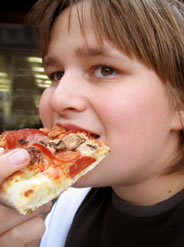
© istockphoto
In one study, Lori A. Francis, Ph.D., and Elizabeth J. Susman, Ph.D., of Pennsylvania State University, State College, assessed self-regulation behavior in 1,061 children. Data were collected when children were ages 3, 5, 7, 9, 11 and 12 years old. At age 3, the children participated in a self-control assessment that involved sitting alone in a room with a toy for 150 seconds. Those who waited at least 75 seconds to play with the toy were classified as high in self-regulation. At age 5, the children participated in an exercise in delayed gratification that involved choosing a smaller portion of a favorite food immediately or a larger portion several minutes later. High self-regulation was defined as waiting at least 210 seconds to eat the food.
Compared with children who showed high self-control on both tests, those who were unable to regulate their behavior at both ages had the highest body mass index (BMI) scores for their age at 12 years and the most rapid increases in BMI over the nine-year follow-up.
“The findings reported herein have potential for early prevention of obesity,” the authors write. “The implication is that interventions to enhance energy-balance regulation in young children will benefit from efforts to encourage self-regulation in other domains, such as encouraging self-control and delay of gratification, both of which are important factors in regulating energy intake.”
In another study, Desiree M. Seeyave, M.B.B.S., of the University of Michigan, Ann Arbor, and colleagues used a similar self-imposed waiting task to gauge 4-year-olds’ ability to delay gratification. The children were asked to choose candy, animal crackers or pretzels as their preferred food and then left alone with two plates of different quantities of the food. “The child was told that he would be allowed to eat the large quantity of the chosen food if he waited until the examiner returned,” the authors write. “If he could not wait until the examiner returned, he could ring a bell to summon the examiner back into the room, at which time he could eat the small quantity.”
Of the 805 children who participated, 47 percent failed the test, either by ringing the bell before the seven-minute waiting period elapsed, spontaneously beginning to eat the food, becoming distressed, going to the door or calling for a parent or the examiner.
Those who displayed a limited ability to delay gratification were 29 percent more likely to be overweight at age 11. The association was partially explained by mothers’ weight status. “The influence of maternal weight status on child weight reflects genetic as well as environmental factors, such as feeding patterns and availability of food,” the authors write.
Parenting techniques may be available to help children develop an ability to delay gratification, the authors note. “Some strategies that have been described in prior studies have been keeping the desired item (in this case, food) out of sight (and therefore out of mind) or distracting the child’s attention from the food to another engaging activity. Another possibility is simply providing a logical structure to snacks and mealtimes such that the child learns that food is not to be eaten the moment it is desired, but to wait until the next snack or meal time,” the authors write.
Source: (Arch Pediatr Adolesc Med. 2009;163[4]:297-302, 303-308. Editorial: Possibilities Exist for Improving Children’s Self-Control
“Can a child’s self-regulation capacity be changed or is it an innate and immutable human trait?” write Robert C. Whitaker, M.D., M.P.H., and Rachel A. Gooze, B.A., of Temple University, Philadelphia, in an accompanying editorial. “Self-regulation is shaped by both nature and nurture; it is influenced by environments and experiences during early childhood.”
“There are not yet any tested ‘office-based’ interventions for improving children’s capacity for self-regulation,” they write. “However, there are promising results from randomized controlled trials showing that interventions in preschools can increase children’s positive social behaviors.”
(Arch Pediatr Adolesc Med. 2009;163[4]: 386-387.
